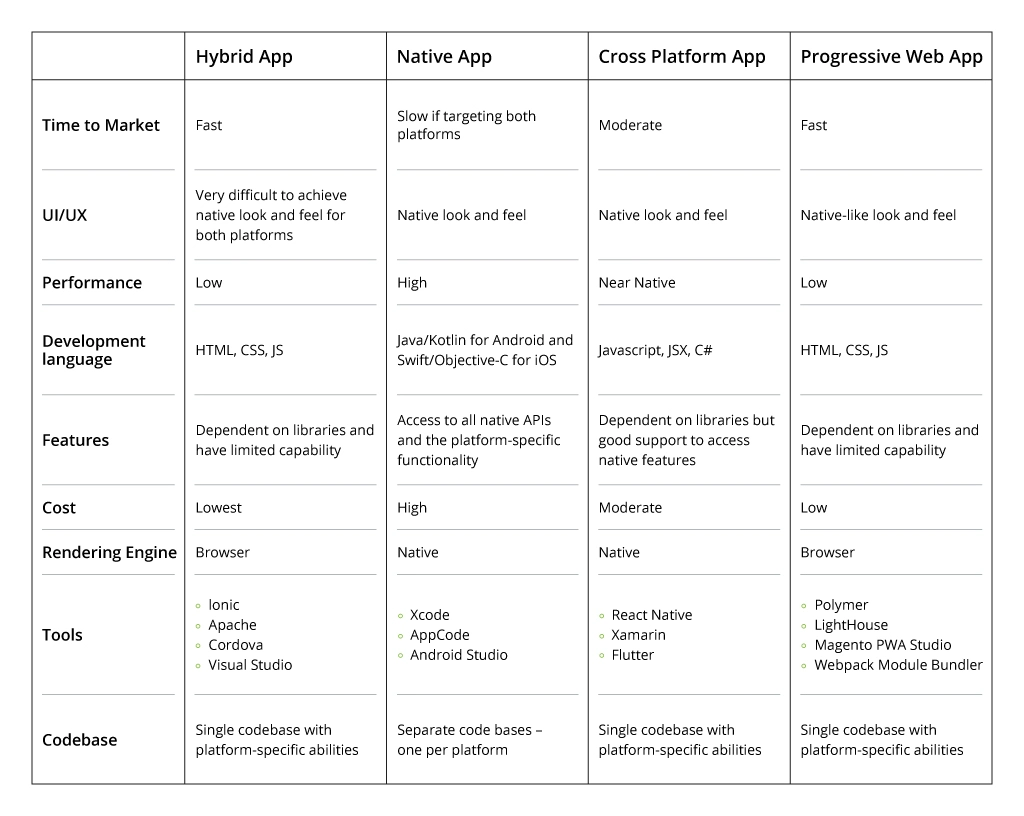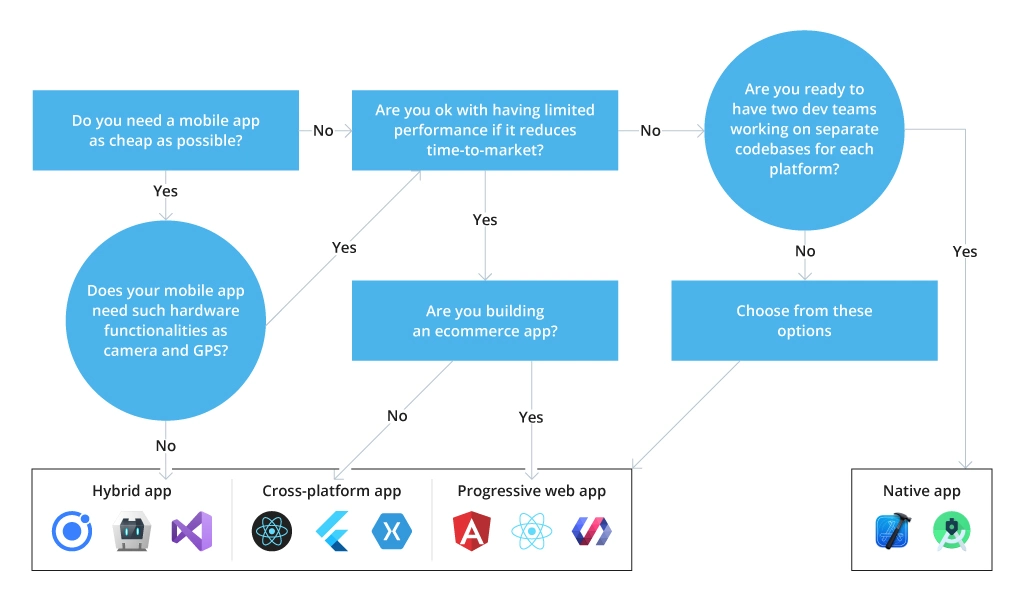How to Choose the Right Technology Stack for Your Mobile App
Finding a product-market fit, framing a relevant business model, and developing an effective marketing strategy – all these factors define the success of a future mobile application. However, having all this on board without choosing the right mobile app technology stack is nonsensical. It defines the future product's performance, usability, resource consumption, and the ability to scale the app features in the future.
So, how do you choose the mobile app tech stack to implement all the functionality, ensure smooth app performance, and not to over budget the project? Here is a guide from Infopulse mobile development experts.
The Components of Mobile App Technology Stack
The mobile development stack combines all technologies used for developing a functional mobile application. There are four main components of a tech stack for mobile app development:
- Platform: an underlying software framework or environment where a mobile app is developed and executed.
- Frontend: programming languages (e.g., HTML5/CSS, JavaScript, etc.), frameworks (e.g., Flutter, React Native, Xamarin, etc.), and libraries to implement the UI and UX design.
- Backend: server-side components and infrastructure that maintain the mobile app functioning. It handles data storage, processing, retrieval, and implementation of the app’s business logic. The backend layer includes servers, databases, APIs, business logic, security and authentication, and cloud services to utilize scalable and reliable infrastructure.
- Hosting: necessary software and hardware environment to run backend components and serve the mobile app’s functionalities.
Besides these critical components, the technology stack for mobile app development may include web services and APIs for a mobile app to interact with external services by retrieving data and performing various operations DevOps – tools and practices for continuous integration, continuous delivery (CI/CD), version control, and automated deployment.
How Does the Development Approach Define the Mobile App Tech Stack?
The mobile app technology stack directly depends on the application type you have chosen. There are four major development approaches for mobile app development, and each one implies its own set of potential technologies to go for.
Native Mobile App Development
Native mobile applications are developed specifically for a particular mobile operating system using the platform’s native programming languages and frameworks. It can be Java or Kotlin for Android and Objective-C or Swift for iOS. Such applications leverage unique (native) features and capabilities of the specific platform they are developed for, usually Android or iOS.
In the case of the native approach, if you need your application to work on multiple platforms, you need to create separate codebases for each platform.
Technologies for Native Mobile App Development

Currently, 95% of the top 1000 native Android apps utilize Kotlin code, making it a more popular language choice over Java.
As for native iOS development, most of the existing iOS applications are written in Objective-C. Developers choose Swift as a more recent, reliable, and robust programming language for new apps.
The Typical Use Cases for Native Mobile App Development
- Performance-critical apps: complex 3D games, multimedia-intensive apps, or applications that heavily rely on real-time data processing. For instance, Infopulse developed an Android application for Bosch Security and Safety Systems that required stability within heavy data loading and processing using a native technology stack for mobile app development.
- Platform-specific user experience: products highly tailored to platform-specific user experience that require a native development approach. This way, Infopulse developed a medical records app for European healthcare solutions providers.
- Offline functionality and performance: native mobile apps that provide robust offline functionality must have control over local data storage, caching mechanisms, and background processing.
Hybrid Mobile App Development
The hybrid approach implies creating one codebase running on multiple mobile platforms. The codebase is created using standard web technologies like HTML, CSS, and JavaScript. The code is wrapped inside WebView – a native container. The content in WebView is rendered as an ordinary website. Such an approach is relatively limited in using hardware functionality (GPS, camera, etc.).
- Programming languages: HTML, CSS, JS
- Development frameworks: Ionic, Cordova, Visual Studio
The Typical Use Cases for Hybrid Mobile App Development
- Utility applications: apps without extensive device integration or complex features (weather apps, calculators, to-do list apps, etc.). For example, Infopulse developed a land management app for Corteva Agriscience to provide end-users a 360-degree view of their farms and fields.
- Internal business apps: functionalities like displaying data, submitting forms, and accessing internal systems can be fully covered with a hybrid development approach. Infopulse engineers created a Cordova-based mobile app for A2B.Direct to make its cargo logistics platform available from mobile devices.
- Content publishing apps: blogs, magazines, news apps, and other products that require consistent user interface across platforms and frequent content updates.
Cross-platform Mobile App Development
It is another approach to creating a mobile application that can run on multiple platforms within a single codebase. It uses platform-agnostic frameworks and native UI components to achieve a native-like user experience while sharing the same codebase. The codebase is written in JavaScript and connects native components using so-called bridges.
- Programming languages: JS, JSX, C#
- Development frameworks: React Native, Xamarin, Flutter
Typical Use Cases for Cross-platform App Development
- Productivity apps: they aim at boosting personal or team productivity that do not require involving native hardware and functionalities. Such apps include to-do lists, calendars, project management apps, and others.
- Internal business apps: the products that prioritize functionality and rapid development cycles over native hardware functionalities and smooth user experience across platforms. For instance, Infopulse created a mobile app for silage control for an agricultural giant to automate silage measurements collection and reporting. Another example is an office space management application: we used Xamarin to create a cross-platform app with a native look and feel.
- Content-based applications: news aggregators, e-commerce platforms, blogs, etc.
Overall, a cross-platform approach can bring tangible cost-savings for enterprise app development. Read how we helped our client, one of the Big Four companies, switch from the initial native mobile app development to Xamarin. The latter significantly reduced costs for the development of enterprise mobility solutions.
Progressive Web Applications
Progressive web apps or PWAs resemble hybrid ones. They are built by using web technologies and provide a native-like experience for all supported devices. PWAs can be installed and run on all devices using one codebase. They can run from a web browser, just like websites, and can continue working when offline.
This type of app adapts to the hardware capabilities of the device they run on, supporting GPS, push notifications, camera access, and other features. However, the technology implies more limitations for the iOS platform: no camera access, no installation API, etc.
Things to Consider When Choosing a Mobile App Technology Approach
When choosing a mobile app development approach, there are many critical factors to consider. The right choice of mobile app tech stack will be defined by the approach, and here is a basic decision matrix to go on the right direction:
In practice, many more factors should be taken into account. Together with your technical team, it makes sense to go through each point:
- Analyze your target audience: location, the area of use, and the market segment you will cover. Also, consider the distribution channels to attract customers and make them prefer your product over competitors.
- Market coverage: Based on the target audience and service specifics, you may need an application for only a particular mobile platform. If your target audience is multi-platform, then consider native for both Android and iOS or cross-platform. The location also matters. For instance, almost 62% of European users prefer Android, while the US market is 55.4% iOS and 44.2% Android.
- The purpose of an app: What problem of your target audience will the product solve? Check how competitors solve the same or similar problem, and the pros and cons of their solutions. Connecting this analysis to their mobile app technology stack may also help you decide on the relevant technologies.
- Time to market: Native development takes longer than hybrids or PWAs. However, when chasing a quick market launch, you should lower expectations for performance and UX.
- Budget: in most cases, developing a cross-platform application is cheaper than developing native apps. If the budget is a crucial business strategy factor, the best technology stack for mobile apps is then cross-platform or hybrid.
- UI/UX: mobile app retention rate on Day 1 is 25.6% for iOS and 22.6% for Android. The impression from the first-time user experience is crucial to keep a customer using the app further. Native is the best in terms of UI. The cross-platform approach gives limited UI capabilities but still wider than hybrid.
- Performance: the business and functional requirements define the required performance speed and data processing capacity, which should also be considered when choosing the mobile app tech stack.
- Functionality: depending on how the functionality relies on hardware capabilities like sensors, cameras, GPS, and others, hybrid or cross-platform approaches may not cover all the product needs.
- Security: in specific industries, including Banking & Financial Services, security is essential for safe customer service and advanced protection for financial operations, including biometrics that involves the use of mobile hardware sensors. That is why banks prefer a native mobile app tech stack. This way, Infopulse engineers implemented a mobile banking app for a group of Nordic banks using the native tech stack.
- Scalability: assess your app's scalability requirements and choose a tech stack for mobile app that can effectively scale the backend, handle increased traffic, optimize performance, and integrate with external services to support the long-term growth and success of your mobile app.
How to Define the Best Mobile App Tech Stack Within the Chosen Development Approach?
To choose the suitable development approach, first examine all the requirements based on the considerations above. It will help us understand which development tools and programming languages within the chosen approach would better fit the future product.
Keep in mind that using the most trending technologies is not always the best choice due to the possible lack of community support and available materials for use during the development process. Another factor that matters is the team size that also depends on your budget limitations. One cross-platform team will cost less than teams for native development.
A new product launch often starts with an MVP development to verify the product idea viability before investing in a complete product version development. At this stage, you should opt for a cost-efficient tech stack for a mobile app to implement the core app functionality and basic user interface. Further, if the project turns viable, you can switch to a native stack or continue extending the product features with the chosen hybrid or cross-platform technology.
Final Words
The mobile app development stack defines the future product success in a great measure. Overall, to select a relevant mobile app tech stack you should follow three essential steps:
- Conduct an in-depth analysis of the project’s business, technical, and functional requirements
- Define the development approach that fits the outlined development scope
- Determine the suitable mobile app technology stack within the chosen approach.
Infopulse has extensive experience in mobile app development for both internal and commercial use. Our mobile software engineers and designers have solid expertise in both native and cross-platform development. We will help to match your project requirements with available technologies for successful and cost-efficient project completion.
![Mobile Tech Stack [main banner]](https://www.infopulse.com/uploads/media/banner-1920x528-how-to-choose-a-mobile-app-development-stack.webp)









![Super Apps Review [thumbnail]](/uploads/media/thumbnail-280x222-introducing-Super-App-a-Better-Approach-to-All-in-One-Experience.webp)
![Security Guide for Cloud Migration [thumbnail]](/uploads/media/thumbnail-280x222-security-when-migrating-apps-to-the-cloud.webp)
![SaaS Application Development [thumbnail]](/uploads/media/thumbnail-280x222-how-to-create-a-saas-app-edited.webp)
![Application Migration Strategies [thumbnail]](/uploads/media/thumbnail-280x222-5-application-migration-strategies-and-how-to-make-them-work.webp)











